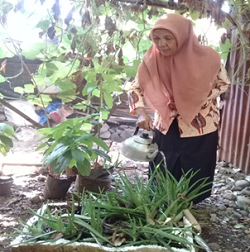Tangguh Hadapi Covid-19 dengan Budidaya Tanaman Obat Keluarga di Desa Margomulyo, Seyegan, Sleman Be Strong to Face Covid-19 Outbreak by Cultivate Herbal Plants for Medicine in Margomulyo Village, Seyegan, Sleman
Main Article Content
Abstract
During the Covid-19 outbreak, it is essential to maintain faith and a happy soul; it is also necessary to maintain our health immunity. The body's immunity can be supported by consuming healthy food and a balanced diet. Consumption of additional supplements from chemical medicine cause side effects if consumed overdoses. By utilizing the land yard for the cultivation of herbal plants, it can be used as an alternative solution to reduce the consumption of chemical drugs, in line with the problems faced by the program partner nursery, which has an extensive collection of medicinal plants but does not yet know the efficacy of each type of plant. The community service program during the pandemic was carried out through limited counseling to 30 health cadres of Margomulyo village. The method used in this activity is public education through lectures, questions, and discussions. Participants were also given a pocketbook "List of Herbal Plants and their benefits and also given plant seeds. Participants' level of knowledge was measured using a questionnaire given before and after the lecture. From the results, it can be seen that there is an increase in the understanding of the participant's post-test scores compared to pre-test scores. Participants' increased knowledge about family medicinal plants was expected to share the knowledge with the broader community and apply the cultivation of herbal plants inland around the house.
Downloads
Article Details
Authors who publish with this journal agree to the following terms:
- Any article on the copyright is retained by the author(s).
- Author grant the journal, right of first publication with the work simultaneously licensed under a Creative Commons Attribution License that allows others to share work with acknowledgment of the work authors and initial publications in this journal.
- Authors are able to enter into a separate, additional contractual arrangements for non-exclusive distribution of published articles of work (eg, post-institutional repository) or publish it in a book, with acknowledgment of its initial publication in this journal.
- Authors are permitted and encouraged to post their work online (e.g., in institutional repositories or on their websites) prior to and during the submission process, as can lead to productive exchanges, as well as earlier and greater citation of published work.
- The article and any associated published material is distributed under the Creative Commons Attribution-ShareAlike 4.0 International License
References
Hadi, S.N., Rahayu, A.Y., Widiyawati, I. 2017. Penerapan Teknologi Berkebun Sayur secara Vertikultur pada Siswa Sekolah Dasar di Purwokerto, Jawa Tengah. Panrita Abdi : Jurnal Ilmiah Pengabdian Pada Masyarakat. 1(2): 114-119. https://doi.org/10.20956/pa.v1i2.2640
Kasim, F., Segara, E.A. 2012. Studi kualitatif mengenai faktor-faktor yang mempengaruhi rendahnya penggunaan tanaman obat keluarga di wilayah kerja Puskesmas Cipeuyeum Kecamatan Haurwangi Kabupaten Cianjur. In Proceeding Simposium Nasional Herbal Medik. Bandung: Universitas Kristen Maranatha
Kusumawaty, Y., Khaswarina, S. 2018. Peningkatan motivasi ibu rumah tangga untuk memanfaatkan tanaman obat keluarga (TOGA). Buletin Udayana Mengabdi. 17(1):7-13. https://doi.org/10.24843/BUM.2018.v17.i01.p02
Paeru, R.H., Dewi, T.Q. 2015. Panduan Praktis Bertanam Sayuran di Pekarangan. Jakarta: Penebar Swadaya
Prita, D.S., Widiyawati, I. 2019. Pengenalan teknologi budidaya tanaman obat sebagai upaya pemanfaatan lahan pekarangan di kelurahan Pabuwaran Purwokerto, Jawa Tengah. Panrita Abdi : Jurnal Ilmiah Pengabdian Pada Masyarakat. 3(2):105-112. https://doi.org/10.20956/pa.v3i2.6155
Sari, D.I., Yuniar, Y., Siahaan, S., Riswati, Syaripuddin, M. 2015. Tradisi masyarakat dalam penanaman dan pemanfaatan tumbuhan obat lekat di pekarangan. Jurnal Kefarmasian Indonesia. 5(2):123-132. http://dx.doi.org/10.22435/jki.v5i2.4407.123-132
Satriyani, E. 2016. Pola tradisi minum jamu: upaya mempertahankan pengobatan lokal sebagai identitas masyarakat Bangkalan Madura. Dimensi : Jurnal Ilmu Sosial dan Ilmu Budaya. 9(2):115-122
Sugito, Susilowati, Al Kholif, M. 2017. Strategi pemanfaatan lahan pekarangan untuk budidaya tanaman obat keluarga (TOGA) Jurnal Penamas Adi Buana. 2(2):1-8
Sumarmiyati, Rahayu, S.W.P. 2015. Potensi Pengembangan Tanaman Obat Lokal Skala Rumah Tangga untuk Mendukung Kemandirian Pangan dan Obat di Samarinda, Kalimantan Timur. Prosiding Seminar Nasional Masyarakat Biodiversitas Indonesia. 1(2):330-336. https://doi.org/10.13057/psnmbi/m010227
Sumiastri, N., Priadi, D., Cahyani, Y. 2011. Variasi Jenis Tanaman Obat dalam Upaya Penggalakan TOGA di Pekarangan Desa Cangkring, Jember. Berkala Penelitian Hayati. 4D: 39-43
